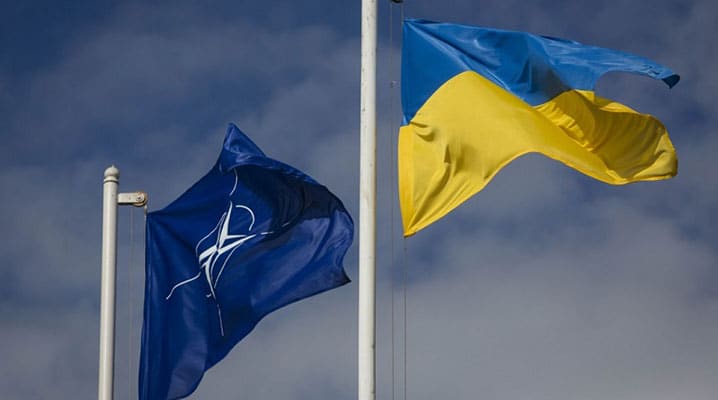Anniversaries invite retrospection of the rosy-hued variety. As the NATO-Ukraine Distinctive Partnership marks its 20th anniversary on 9 July, there are certainly successes to highlight. Ukraine’s contributions to Euro-Atlantic security – including substantial participation in NATO-led operations in the Western Balkans – have made a major difference in a difficult region. And NATO and Ukraine have built an impressive toolbox capable of supporting a broad set of reforms.
In several important areas, however, the Distinctive Partnership has fallen short of expectations. Prior to the 2014 Russian invasion, whenever Ukraine sought NATO support in addressing its biggest existential threat – increasing pressure from Putin’s Russia – it frequently found the Alliance reluctant to even discuss the issue.
Ukraine’s reaction, a hyper-focus on joining NATO’s Membership Action Plan, has been counterproductive, wasting precious political capital and distracting attention from implementing important reforms for nearly a decade. This prioritisation of symbolic steps over substantive reform by Ukraine, along with a corresponding resilience of that country’s legacy institutions and practices, has been frustrating for Allies.
As the Distinctive Partnership turns twenty, it is in the midst of reinvigoration and renewal. The 2014 Revolution of Dignity ended the period of neglect that characterized the ill-fated presidency of Viktor Yanukovych (2010-2014). The Alliance has mobilised substantial resources to support Ukraine in its defence against Russian aggression – and to rebuild defence institutions that were badly eroded during the Yanukovych years.
This renewal represents an opportunity to build a more satisfying relationship: one that builds on strengths, avoids dissatisfactions and provides real results for Ukraine’s two most pressing needs – preserving its independence and modernizing its state institutions.
Four lessons
Looking back across two decades of the NATO-Ukraine Distinctive Partnership, and considering my own official role for ten years of that, four major lessons stand out as being particularly relevant for building the relationship today.First: Give Ukraine – and the Distinctive Partnership – credit where it is due.
At the time the Charter was signed in 1997, NATO’s Partnership for Peace (PfP) had successfully engaged former Warsaw Pact, newly independent states and nonaligned Western European countries in a common framework of dialogue and cooperation.
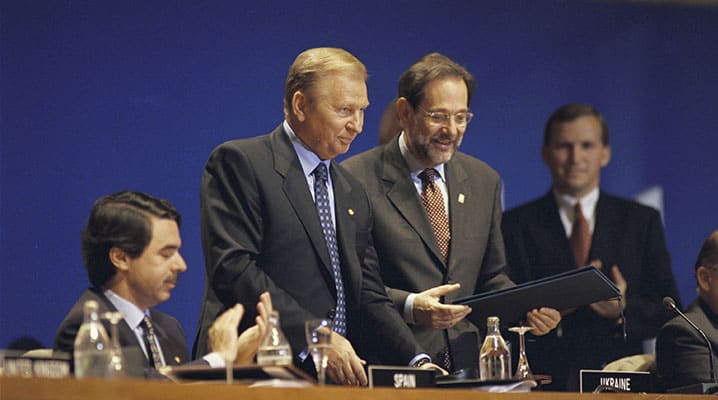
On 9 July 1997 NATO and Ukraine signed a Charter on a Distinctive Partnership at the NATO Summit in Madrid. © NATO
Yet PfP was far from a stable end state. Central European and Baltic countries were clamouring for membership in the Alliance. Three – the Czech Republic, Hungary and Poland – had been invited to start accession talks. Russia, by contrast, looked to develop a privileged ‘Special Relationship’ with NATO as a tool to help preserve its ‘historical’ sphere of influence and keep NATO´s policies in check. For NATO members, the burden of Europe’s history still loomed large – the fear that without active efforts to ‘win the peace,’ horrors like the breakup of Yugoslavia or the instability of Eastern Europe’s Interwar Period could easily return.
Ukraine deserves substantial credit for its consistently constructive role in this complex region. Ukraine’s commitment to the principles for inter-state relations of the Organization for Security and Co-operation in Europe has been an important factor in ensuring stability on NATO’s borders and in the Black Sea region. Its full participation in PfP, and consistent, substantial contributions to NATO operations have set a high standard for partnership and provided a welcome contrast to Russian behaviour. And Ukraine – faced in 1997 with an economy in a seven-year contraction, a declining population and unpredictable politics – has made incremental progress (albeit often haltingly) on the economic, political, and national security reforms needed to avoid disaster.
The Distinctive Partnership’s regular dialogue has encouraged and facilitated Ukraine’s constructive regional contribution. Where there have been strains, joint consultations have worked as an important stabiliser: in one notable example, during the 2001 dispute over Ukraine’s arms sales to the former Yugoslav Republic of Macedonia1, information on operational realities in that country, shared at a joint expert meeting, helped Ukrainian officials to better understand the context of Allied concerns and modify their policy.
Second: Make best use of current mechanisms and initiatives.
NATO and Ukraine have developed a tremendous toolkit, mostly during the Distinctive Partnership’s first five years. These range from tools providing strategic planning and advice across a broad agenda of reforms and institution building with targets set and reviewed annually, through joint working groups in specific areas such as defence reform, economic security and technical cooperation, down to practical programmes and projects focused on issues such as professional development or the destruction of small arms and light weapons.
NATO’s in-country offices – the NATO Liaison Office, which facilitates Ukraine’s participation in the PfP programme and supports its defence and security sector reform efforts, and the NATO Information and Documentation Centre – have boosted NATO-Ukraine work significantly by building direct relationships with the myriad of stakeholders involved in a given issue and helping to harmonise their combined efforts. The recent amalgamation of the two offices into a common NATO Representation was a positive step to reduce organisational friction; further re-configuration, however, should carefully consider the functional impact on these essential stakeholder relationships.
To those considering new initiatives, the saga of Ukraine’s efforts to enter the Membership Action Plan (MAP) – and the Alliance’s struggles in responding – should serve as a cautionary tale. In December 2001, Ukraine suggested a choreographed move to MAP, to counterbalance increased Russian pressure. Allies, sceptical of Ukrainian President Kuchma’s sincerity, crafted a compromise: an ‘Action Plan’ adopted at the Prague summit in November 2002 that would allow for intensive consultation, cooperation, and assessment across the political, economic, and national security areas necessary to meet NATO membership standards – in essence, MAP without the ‘M’.
Lacking the magic letter, however, this powerful new tool was grossly underused. And ‘joining MAP’ became the holy grail of Ukrainian diplomacy. The result was an Alliance divided, perceptions of failure from major NATO-Ukraine meetings, and serious opportunity costs. On at least two occasions, in 2005 and again in 2007-2008, the quest for MAP crowded out practical initiatives designed to focus political attention and resources on Ukraine’s real-world vulnerabilities. Those were missed opportunities of historical proportions.
Third: Institutions are the glue that makes reform stick.
Ukraine’s formal institutions have frequently proven a weak vessel for carrying forward the knowledge and know-how gained from work with the Alliance. Ukrainian units would train to PfP standards, but their core manuals would remain unchanged. A unit would be put together for deployment to an operation, only to have its members sent back to home units on their return. Officers would go for training abroad, only to find their new-found experience was valued more by civilian think tanks than the Armed Forces.
In response, on the fifth anniversary of the Distinctive Partnership in 2002, the frank assessment of those of us managing NATO-Ukraine military cooperation was along the lines of “substantial success in specific activities, but with limited systemic impact.” That Ukraine’s Military Representative in Brussels agreed with this assessment, against political pressure, was a testament to the openness of the military relationship. It was also his chance to criticise the Ukrainian Armed Forces’ tendency to treat experience gained through NATO events as something alien to core doctrine and procedures.
The weakness of formal institutions within the Ukrainian context is an unfortunate reality, though, and projects and programmes that fail to understand and mitigate that reality will naturally produce disappointing results. Conversely, those projects that have been most successful and enduring have developed their own institutional basis. The Professional Development Programme (PDP), for example, included a project-specific joint committee. And to coordinate the plethora of defence advisory efforts underway in 2007-2009, a joint coordinating committee was created within the Ministry of Defence, chaired by the MOD policy director, with the NATO Liaison Office supporting.
The principles for success in these joint management efforts were straightforward: transparency of information, adherence to standards and procedures, and joint responsibility to higher authorities. Working-level projects like the PDP would report to the Joint Working Group on Defence Reform and, through that, to the NATO-Ukraine Commission, which directs cooperative activities and provides a forum for consultation between the Allies and Ukraine. There is little that better serves to focus the mind of one’s counterpart than the prospect of a joint presentation in Brussels – with the results included in a report to defence ministers.
In contrast to the weakness of Ukraine’s formal institutions, that country’s informal institutions and personal connections are strong. These are the mechanisms that Ukrainians have relied on for centuries to get things done – often in spite of the formal institutions. In recent years, these informal institutions have been a driving force for social change, most recently in the remarkable volunteer efforts that successfully filled in major gaps in the defence system – logistics, training, medical support, maintenance, procurement, and others – to mobilise and deploy Ukrainian combat units to Ukraine’s east in 2014. Where NATO-Ukraine cooperation can harness the energy and persistence of these informal institutions, they will be a powerful force for lasting change.
Fourth: Remember Values.
While the ‘frank’ assessment mentioned above was accurate, it was also woefully incomplete – a fact I discovered in the spring of 2004, as the recently-arrived head of the NATO Liaison Office in Ukraine. On the occasion of a visit to a unit recently assigned to work in PfP, the commander took the opportunity publicly to introduce me to a number of former unit commanders who were also visiting – Soviet colonels and generals – and openly told them: “We work with NATO now; it’s our future.”
The importance of that simple act of courage was driven home a few months later, on the 22 November 2004, when that unit – with thousands of men and hundreds of armoured vehicles – received orders to take up blocking positions around the capital, Kyiv, in preparation for crushing protests against election fraud that had broken out in the centre. The commander, at considerable personal and professional risk, refused.
That principled stand, echoed multiple times by his fellow commanders, had a profound impact on Ukraine’s history, directly contributing to the success of the Orange Revolution, which peacefully overturned a falsified election. It also put the armed forces squarely on the side of democracy in the longer term – a fact that again played an important role in the 2014 Revolution of Dignity.
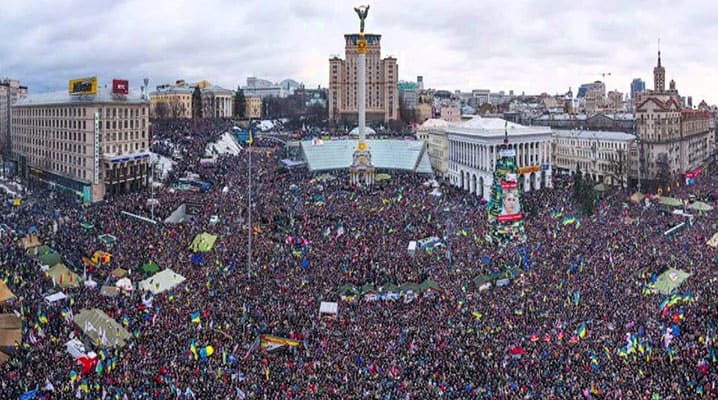
In the wake of the 2014 Revolution of Dignity (known as Euromaidan) and the fall of President Viktor Yanukovych, Russia deliberately destabilised eastern Ukraine and illegally annexed Crimea. In response, the Alliance has mobilised substantial resources to enhance Ukraine’s ability to provide for its own security.
In the face of the 2002 “limited systemic impact” assessment, this was a humbling lesson: the dynamics at play in the NATO-Ukraine relationship go far deeper than the metrics of project assessment. Ukraine’s military professionals see their service to their country and its people, not a political regime. By late 2004, over 20,000 servicemen had participated in NATO-led or UN peacekeeping operations, had worked side-by-side with NATO counterparts, and felt themselves a part of a professional community in which attacking one’s own citizens was anathema. The figure today is nearly double that.
This sense of affinity is widespread in the armed forces: as one Ukrainian Chief of Defence shared: “My Russian counterpart and I have a common language, so it is easy for me to talk with him. But I have far more to talk about with my Spanish colleague.” This affinity is also shared by the overwhelming majority of Ukraine’s strategic thinkers, both in and out of government, who have strong relationships with Western colleagues, openly seek their advice in drafting policy proposals, and – frankly – see no other viable options for their country.
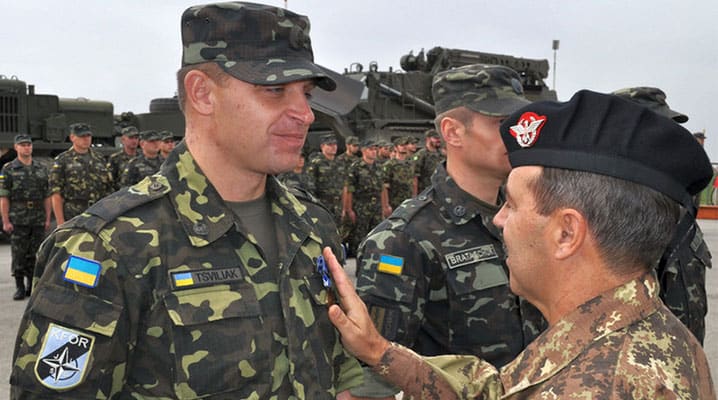
Ukrainians have served in NATO-led peace-support operations, working side-by-side with NATO counterparts, first deploying to Bosnia and Herzegovina in 1996, to Kosovo in 1999 and Afghanistan in 2007.
Looking forward from twenty
After years of relative quiet, the combination of Ukraine’s Revolution of Dignity and Russian aggression in Crimea and Donbas has impelled the NATO-Ukraine Distinctive Partnership into another period of intense activity. In responding to this aggression, NATO has played an important role in strategic communications in both the public and inter-governmental contexts, clarifying the facts of Russian aggression and debunking disinformation. The Alliance – NATO and individual Allies – has also mobilised substantial resources to support Ukrainian operations and build badly needed capabilities.
The challenge looking forward will be using those resources effectively to achieve lasting results. The tools of the Distinctive Partnership have proven themselves capable of doing this in the post-Orange Revolution period. The NATO-Ukraine Commission and the network of committees and programmatic tools under it can ensure clear information flow, provide joint management, and keep political dialogue and practical work linked. . NATO’s in-country representation has a natural role in harmonising the activity of the various actors – NATO programmes, Allies, and Ukrainian institutions – a process essential for success. The Trust Fund mechanism can ensure that practical projects are sustainably supported – if Allies allocate sufficient support from national budgets.
In the press of practical projects, it will be important to not ignore the policy and political levels – and their link with discussion in wider society. Strategic communications has an important role to play, as do efforts to strengthen links between strategic thinkers in the Alliance and Ukraine, and empower their voice in policy and reform dialogue.
Finally, and most importantly, the Alliance should remember that one of the greatest successes of the Distinctive Partnership has been to build affinity at the human level – affinity built on common work in support of common values. For the armed forces, much of the day-to-day, shoulder-to-shoulder work has been in the context of PfP and NATO operations. With the centre of gravity for Ukrainian operations now in the East, where there are restrictions on the activity of NATO and Allied personnel, there is a risk that this regular contact will be diminished.
There is another risk to this affinity: lingering resentment caused by what is seen in Ukraine – with some substantial justification – as an inadequate initial Western response to Ukraine’s requests for defence assistance following Russia’s invasion in early 2014. This resentment damages the Alliance’s moral authority and political capital with Ukrainian counterparts, hampering efforts to address problem areas.
This damage is serious; if left unaddressed, it could lead to a cycle of frustration, disillusionment, and disengagement. But it is not irreparable – if the Alliance collectively (or sufficient Allies individually) acknowledges the shortfall and takes stronger action to live up to its commitments to support Ukraine’s sovereignty, independence, and territorial integrity, as set out in Article 14 of the NATO-Ukraine Charter.
To be even minimally credible, I believe this must include the long-overdue provision of defensive weapons to Ukraine (together with the associated training, support, and introduction of new operational methods). By focusing on countering advantages that Russia would rely on in a wider war – in areas like armour, air power, electronic warfare, and strategic intelligence – such assistance would support deterrence and increase strategic stability. More regular presence of Allied personnel in and around Ukraine (outside the combat zone) and increased operational cooperation in areas like airspace control, air defence, and host nation support would also substantially increase deterrence – and give Allies more political capital in encouraging Ukrainian reforms.
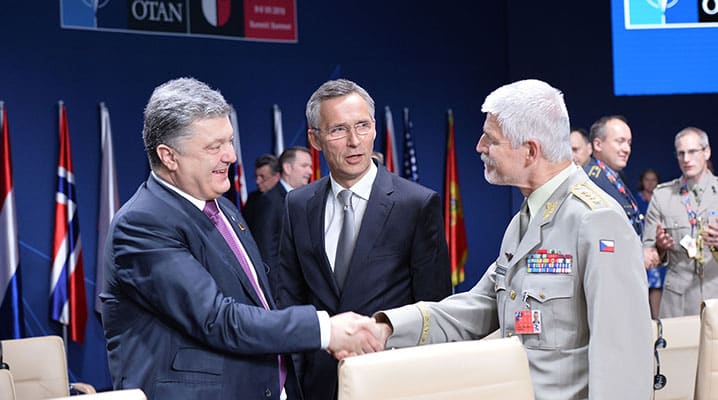
(Left to Right) President Petro Poroshenko, NATO Secretary General Jens Stoltenberg and Chairman of the NATO Military Committee Petr Pavel greet each other at the meeting of the NATO-Ukraine Commission in Warsaw, where Allied leaders pledged further support to Ukraine – 9 July 2016. © NATO
Ukraine, too, has a responsibility to acknowledge the Alliance’s lingering frustrations, and act to address them. At a minimum, Ukraine should ensure that NATO and Allies see results from the resources they commit, by fully incorporating cooperation and reform programmes into national plans and more transparently managing and assessing them. Ukraine’s military leadership could also provide an example of patriotic moral courage by proactively planning a generational transition, identifying personnel with experience both in combat and in cooperation with the Alliance as the next generation of leaders, grooming them with relevant experience, including leadership in the field and education abroad, and moving them into senior leadership positions.
Three toasts
As officials and well-wishers gather in Kyiv and Brussels on 9 July to mark the 20th anniversary the NATO-Ukraine Distinctive Partnership, they will have every right to raise their glass to success – but with caveats.
Ukraine is more firmly within the Euro-Atlantic security space than it has ever been before – but short of where it could be. The breath and depth of cooperation programmes and advisory missions is the greatest that Kyiv has ever seen, although the assessment of “limited systemic impact” all too often still applies. Tens of thousands of soldiers, officials, experts, journalists, parliamentarians and regular citizens share an affinity through the Partnership, and we will have every right to join in raising a glass to our small share in that success.
We will also have a solemn responsibility to remember the souls of the thousands of Ukrainians who have lost their lives from Russian aggression in the past three years, the struggles of millions who have been forced from their homes, and the daily sacrifice of the hundreds of thousands of professionals – military and civilian – who stand guard to deter a wider war, protect against a growing wave of cyber attacks, and counter disinformation targeted at our core democratic institutions. It is into this more dangerous world that the Distinctive Partnership is travelling – a world where the stakes are higher then they have ever been.
We should save a third toast for those entrusted to lead the Distinctive Partnership today: that they have the wisdom to carry forward the lessons of the past, the courage to put to rest lingering disappointments and resentments, and the energy and imagination to successfully carry the NATO-Ukraine relationship forward into this dangerous new world.
1Turkey recognises the Republic of Macedonia with its constitutional name.

